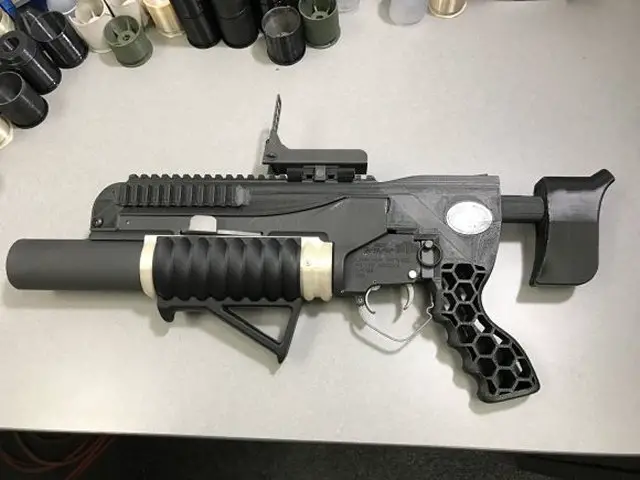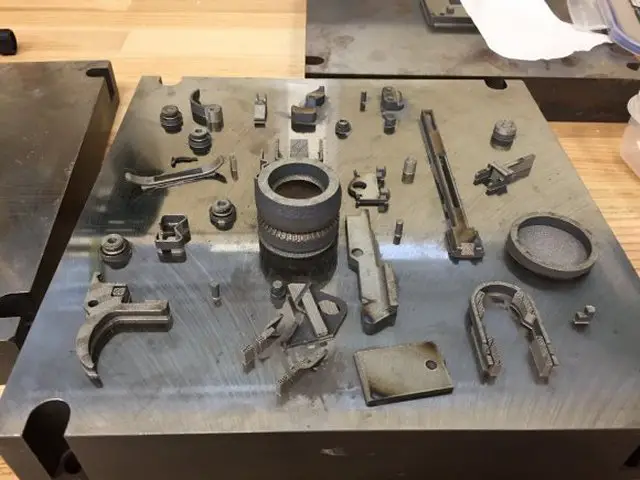|
|
|||
|
Military Defense Industry Technology - USA
|
|||
|
|
|||
| US Army test-fired RAMBO 3D printed Grenade launcher and M781 practice grenade | |||
|
Researchers at the U.S. Army Armament Research, Development and Engineering Center (ARDEC) successfully fired the first grenade created with a 3-D printer from a grenade launcher that was produced the same way. This demonstration shows that additive manufacturing (commonly known as 3-D printing) has a potential future in weapon prototype development, which could allow engineers to provide munitions to Soldiers more quickly.
|
|||
|
|
|||
 RAMBO 3D printed grenade launcher (credit: US Army)
|
|||
|
|
|||
| The printed grenade launcher, named RAMBO (Rapid Additively Manufactured Ballistics Ordnance), was the culmination of six months of collaborative effort by the U.S. Army Research, Development and Engineering Command (RDECOM), the U.S. Army Manufacturing Technology (ManTech) Program and America Makes, the national accelerator for additive manufacturing and 3-D printing. Every component in the M203A1 grenade launcher, except springs and fasteners, was produced using AM techniques and processes. The barrel and receiver were fabricated in aluminum using a direct metal laser sintering (DMLS) process. This process uses high-powered precision lasers to heat the particles of powder below their melting point, essentially welding the fine metal powder layer by layer until a finished object is formed. Other components, like the trigger and firing pin, were printed in 4340 alloy steel, which matches the material of the traditional production parts. The purpose of this project was to demonstrate the utility of AM for the design and production of armament systems. A 40 mm grenade launcher (M203A1) and munitions (M781) were selected as candidate systems. The technology demonstrator did not aim to illustrate whether the grenade launcher and munition could be made cheaper, lighter or better than traditional mass-production methods. Instead, researchers sought to determine whether AM technologies were mature enough to build an entire weapon system and the materials' properties robust enough to create a properly functioning armament. |
|||
|
|
|||
 3D printed parts of the RAMBO grenade launcher (credit: US Army)
|
|||
|
|
|||
|
Beyond AM fabrication of the weapon system, ManTech also requested that a munition be printed. Two RDECOM research and development centers, the U.S. Army Edgewood Chemical and Biological Center (ECBC) and the U.S. Army Research Laboratory (ARL), participated in this phase of the project to demonstrate RDECOM's cross-organizational capabilities and teaming. An integrated product team selected the M781 40 mm training round because it is simple and does not involve any energetics--explosives, propellants and pyrotechnics are still awaiting approval for use in 3-D printing.
In current production, the M781 projectile body is made of zinc. Zinc is used because it's easy to mass-produce through die-casting, it's a dense material and it's relatively soft. The hardness of the projectile body is critical, because the rifling of the barrel has to cut into the softer obturating ring of the projectile body. The rifling imparts spin on the round as it travels down the barrel, which improves the round's aerodynamic stability and accuracy once it exits the barrel. Currently, 3-D printing of zinc is not feasible within the Army. Part of the beauty of AM is that changes can be made quickly and there is no need for retooling. Testing included live firing at indoor ranges and outdoor test facilities. The system was remotely fired for safety reasons, and the tests were filmed on high-speed video. The testing included 15 test shots with no signs of degradation. All the printed rounds were successfully fired, and the printed launcher performed as expected. There was no wear from the barrel, all the systems held together and the rounds met muzzle velocities within 5 percent of a production M781 fired from a production-grade grenade launcher. |
|||














